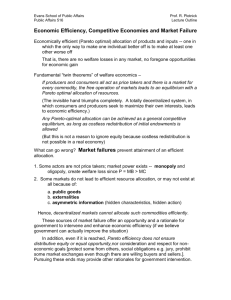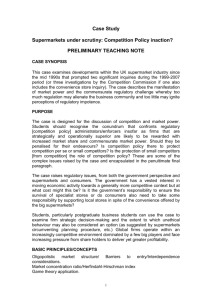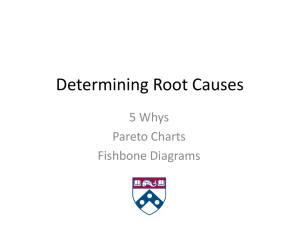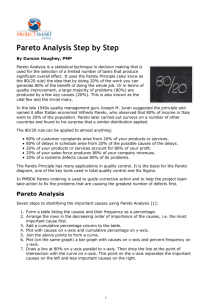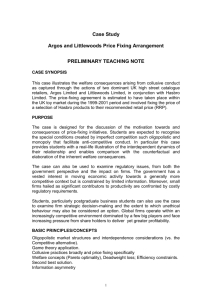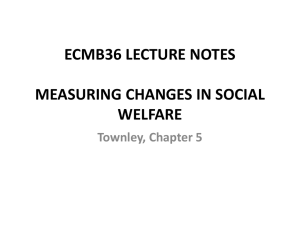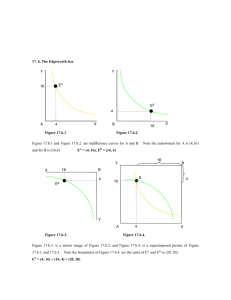Topic 1 notes - staff.city.ac.uk
advertisement
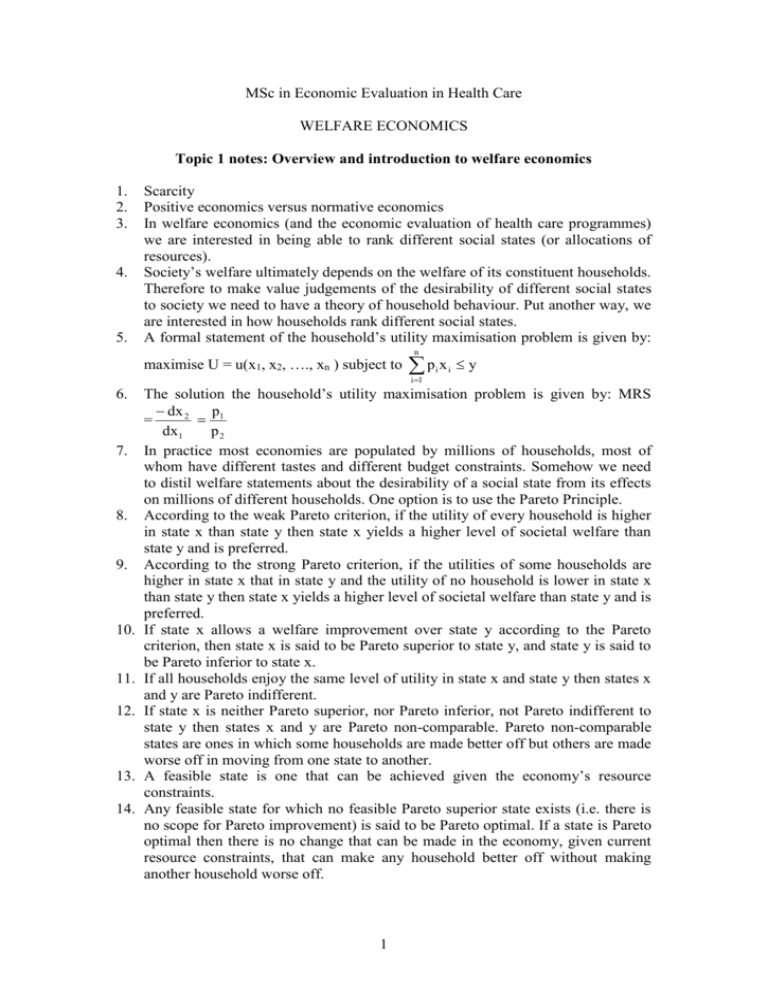
MSc in Economic Evaluation in Health Care WELFARE ECONOMICS Topic 1 notes: Overview and introduction to welfare economics 1. 2. 3. 4. 5. Scarcity Positive economics versus normative economics In welfare economics (and the economic evaluation of health care programmes) we are interested in being able to rank different social states (or allocations of resources). Society’s welfare ultimately depends on the welfare of its constituent households. Therefore to make value judgements of the desirability of different social states to society we need to have a theory of household behaviour. Put another way, we are interested in how households rank different social states. A formal statement of the household’s utility maximisation problem is given by: maximise U = u(x1, x2, …., xn ) subject to n p x i 1 6. 7. 8. 9. 10. 11. 12. 13. 14. i i y The solution the household’s utility maximisation problem is given by: MRS dx 2 p 1 = dx 1 p2 In practice most economies are populated by millions of households, most of whom have different tastes and different budget constraints. Somehow we need to distil welfare statements about the desirability of a social state from its effects on millions of different households. One option is to use the Pareto Principle. According to the weak Pareto criterion, if the utility of every household is higher in state x than state y then state x yields a higher level of societal welfare than state y and is preferred. According to the strong Pareto criterion, if the utilities of some households are higher in state x that in state y and the utility of no household is lower in state x than state y then state x yields a higher level of societal welfare than state y and is preferred. If state x allows a welfare improvement over state y according to the Pareto criterion, then state x is said to be Pareto superior to state y, and state y is said to be Pareto inferior to state x. If all households enjoy the same level of utility in state x and state y then states x and y are Pareto indifferent. If state x is neither Pareto superior, nor Pareto inferior, not Pareto indifferent to state y then states x and y are Pareto non-comparable. Pareto non-comparable states are ones in which some households are made better off but others are made worse off in moving from one state to another. A feasible state is one that can be achieved given the economy’s resource constraints. Any feasible state for which no feasible Pareto superior state exists (i.e. there is no scope for Pareto improvement) is said to be Pareto optimal. If a state is Pareto optimal then there is no change that can be made in the economy, given current resource constraints, that can make any household better off without making another household worse off. 1 15. There are a number of problems with the Pareto Principle: the Pareto ranking of states is incomplete (there exists Pareto non-comparability); the Pareto Principle is neutral to the distribution of utility; and, the Pareto Principle can conflict with liberalism. 16. An attempt to partially overcome the problem of Pareto non-comparability and increase the power of the Pareto Principle is given by the compensation principle. Two different versions of the compensation principle have been proposed. The compensation principle proposed by Kaldor says that state a is preferred to state b if the gainers from the move to state a can hypothetically compensate the losers so that everyone is better off. The compensation principle proposed by Hicks says that state a is preferred to state b if the losers from the proposed move cannot hypothetically bribe the gainers not to make the move. 17. There are a number of problems with the compensation principle: the redistribution is hypothetical only; the hypothetical redistribution is assumed to be costless; the Pareto Principle is still unable to rank different Pareto optimal allocations relative to one another (there are still Pareto non-comparable states); and, the compensation principle may lead to contradictions (as shown by the Scitovsky Paradox). 18. The most important and useful aspect of the Pareto Principle is the relationship between Pareto optimality and the equilibrium of an economy in which resources are allocated by an ideal market mechanism. The first fundamental theorem of welfare economics states that under certain assumptions a state (i.e. an allocation of goods and factors) resulting from a competitive equilibrium is Pareto optimal. 19. The first fundamental theorem of welfare economics requires: efficient exchange p * of goods and services MRS a MRS b 1 an allocation is achieved on p2 * the Community Indifference Curve; efficient allocation of the factors of r* production MRTS a MRTS b an allocation is achieved on the w* Production Possibilities Curve; and, efficient output choice (overall efficiency) MRS = MRT an allocation is achieved where the Community Indifference Curve is tangential to the Production Possibilities Curve. 20. Geometrically, the efficient exchange of goods and services and the efficient allocation of the factors of production may be reached by attaining a point on the contract curve in the relevant Edgeworth box. 21. A complete and consistent ranking of social states is called a social welfare ordering (SWO). Just as with household preferences, if a continuity assumption is also made the SWO can be represented by a social welfare function (SWF) that assigns a number to each social state so that they might be ranked. 22. We cannot achieve an SWO without someone making value judgements about the desirability of different social states. Value judgements are statements of ethics that cannot be found to be true or false on the basis of factual evidence. The value judgements found in an SWO may be weak (i.e. broadly accepted) or strong (i.e. controversial). 23. SWO possibilities are limited by informational requirements that pertain to the measurability and comparability of households’ utility. 24. There are four possible measurability assumptions: ordinal scale measurability; cardinal scale measurability; ratio scale measurability; and, absolute scale measurability. 2 25. There are three possible comparability assumptions: non-comparability; partial comparability; and, full comparability. 26. The Arrow Possibility Theorem states that if household utility is measurable on an ordinal scale and utility is non-comparable across households the only possible SWO is a dictatorship. That is, social orderings must coincide with the preferences of some arbitrary household in the economy regardless of the preferences of the others. 27. Other forms of the SWF are feasible depending on the measurability and comparability assumptions one is prepared to make. Such SWOs include: Bergsonian SWO; Bernouilli-Nash SWO; generalised Bernouilli-Nash SWO; generalised utilitarian SWO; positional dictatorship (e.g. maximin, maximax); positional lexicographic SWO (e.g. leximin, leximax); and, utilitarian SWO. 28. Markets fail, so that the conditions for the first fundamental theorem of welfare economics to hold are not met for the following reasons: non-competitive behaviour; externalities resulting from a lack of property rights; externalities resulting from jointness in consumption and production, including public goods; and, informational externalities. 29. Governments intervene to address such market failures. Additionally governments intervene for the following reasons: the theory of second best suggests that governments should intervene even in unconstrained sectors of the economy if a market failure occurs elsewhere in the economy; to provide the institutional and legal framework under which the market operates; to redistribute income; and, to provide merit goods and limit/ban provision of demerit goods. 30. Whenever an activity by one agent influences the output or utility of another agent and this effect is not priced by the market an externality is said to exist. 31. Where there exists positive externalities arising from jointness in the consumption of goods such as health care due to altruism, then the result is a caring externality. Such caring externalities may also be reciprocal across households. 32. Public goods have two related features: non-excludability, which means that my consumption of the good does not exclude your consumption of it; and, nonrivalry, which means that my consumption of the good does not decrease the amount of it left for you. 33. The level of provision of pure public goods is Pareto optimal when the sum of the marginal rates of substitution (MRS) of private goods (Pr) for public goods (Pu) across all households in the economy is equal to the marginal rate of transformation (MRT). In other words: MRS Pr,Pu MRTPr,Pu 34. To construct the aggregate demand curve for public goods we add the demand curves for individual households vertically. Vertical summation is appropriate because a pure public good is necessarily provided in the same amount to all individuals. 35. Operationally a Pareto optimal allocation of public goods can be achieved using the Lindahl equilibrium. The Lindahl equilibrium states that a Pareto optimal provision of public goods can be achieved at the output level where the aggregate level of demand equals the aggregate level of supply, as above. In the Lindahl equilibrium all households enjoy the same provision of the public good, but they differ in the (tax) prices that they pay for the good, where the tax price is determined according to the marginal willingness to pay of each household. 3 36. Public choice is the study of the political mechanisms and institutions that explain government and individual behaviour. It can be defined simply as the economic study of non-market decision-making. 37. In a democratic economy, decisions made by the government about the desirability of social states are made in three stages: 1. Households vote for elected representatives (politicians); 2. Politicians vote for the desirability of social states (e.g. a particular allocation of government expenditure); and, 3. Bureaucrats, who work for administrative agencies, act on the outcome of the vote by the politicians (e.g. they spend their specific allocation of government expenditure). 38. Politicians face two problems: how do they ascertain the views of their constituents? (This is the problem of preference revelation); and, how do they reconcile differing views across constituents? (This is the problem of aggregating preferences). 39. One way of addressing these problems is through voting. Perhaps the most widely employed rule for decision-making in a democracy is majority voting, which says that in a choice between two alternatives, the alternative that receives the majority of the votes (i.e. 50% + 1) wins. 40. There are three factors that will influence an individual voter’s attitudes towards a particular level of public provision: the voter’s attitudes towards the good; the voter’s income; and, the nature of the tax system. 41. The median voter is the voter for whom the number of voters who prefer a higher level of provision is exactly equal to the number of voters who prefer a lower level of provision. The majority-voting level of provision is the level that is most preferred by the median voter. 42. There are a number of problems with the majority voting equilibrium: A majority voting equilibrium may not exist; and, the majority voting equilibrium, if it does exist, may not be Pareto optimal. 43. Government intervention may not be desirable for two reasons: the government requires some means of addressing the problem of preference revelation and the problem of aggregating preferences; and, there may be government failures, where, even if governments do possess some means of revealing and aggregating preferences government intervention is still undesirable on the grounds that it is Pareto inferior (or at best Pareto indifferent) to no government intervention. 44. The empirical application of welfare economics is the study of applied welfare economics. 45. We can construct two measures of welfare change using a money metric: the compensating variation (CV) and the equivalent variation (EV) 46. The CV of a move from state 0 to state 1 is defined as the amount of income (positive or negative) that the household would pay in state 1 in order to leave it as well off as it was in state 0 (= the maximum amount the household would pay to secure the change). 47. The EV of a move from state 0 to state 1 is defined as the amount of income (positive or negative) that the household would accept in state 0 in order to leave it as well off as it would be in state 1 (= the minimum payment the household would accept to forego the change). 48. A change in social welfare from state 0 to state 1 is given by: W = H a v CV , j1 j j j where aj, is the welfare weight that society attributes to each household j in the economy and vj, is the marginal utility of income of household j. 4 49. Social cost-benefit analyses in practice usually estimate W n CV j1 j z C where CVjz is the CV pertaining only to the increase in health status z obtained by the n individuals who receive the health care programme and C includes: all direct medical and health care costs; medical and health care costs associated with any adverse effects of the health care programme; savings in medical and health care costs arising from the prevention or alleviation of disease caused by the health care programme; and, medical and health care costs incurred from treating diseases that would not have occurred if the patient had not lived longer as a result of the health care programme. 50. In a social cost-benefit analysis the appropriate decision rule is the net present T B Ct value (NPV), given by NPV t , where r is the (one-period) social t t 0 (1 r ) time preference rate. 51. In cost-effectiveness analyses typically the desirability of a project is described in terms of a ratio of incremental costs to incremental benefits. Such an incremental C cost-effectiveness ratio (ICER) may take the following form: ICER = . ( z1 z 0 )T C 1 , where 1/g is the 52. The proposed project should be implemented if ( z1 z 0 ) T g critical cost-effectiveness ratio. Acknowledgement: These notes are closely based upon those initially developed for this course by Stephen Morris. I am grateful to Steve for allowing the use of his teaching materials. 5


